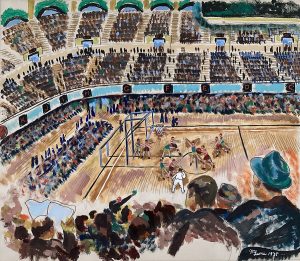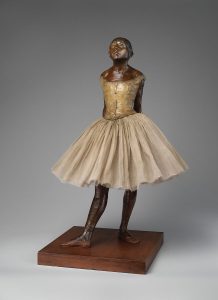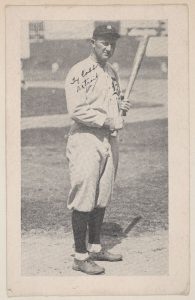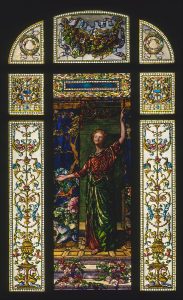12 Chapter 12: How to look at modern art
Maria Americo
Chapter 12: How to look at modern art
In this chapter, we leave historical art behind, and practice using our tools for looking at art on some modern pieces of art.
One of the challenges of studying ancient art history is that we, as modern viewers of the art, lack context, or the unspoken, shared cultural understandings that we rely on when interacting with people from our same time, place, culture, language, religion, or other marker of identity. This is why, in this textbook, we’ve explored a little bit about each art piece historically before “reading” it ourselves as a primary source—to provide the context we would need in order to understand it.
On the flip side, this means that, in order to study modern art, we won’t need such historical explanations—we can rely on our own shared cultural context. Therefore, for our five pieces of modern art, we will skip the historical contextualization and go directly to the questions for reflection. Let’s use our tools for looking at art on some pieces from our own historical time period.
“The Little Fourteen-Year-Old Dancer”
Degas (France)
1922 (the tutu was restored in 2018!)
-Image by the Metropolitan Museum of Art, used under a Creative Commons Zero (CC0) license, Public Domain
-Learn more about this art and find the image source here.
Questions for reflection
- Who was the person depicted in this sculpture? What was her profession?
- What is the mood and “vibe” of this sculpture? How does the figure feel? What emotional sense does this piece evoke?
- People have described this sculpture as “creepy,” and it has received a lot of criticism for a variety of reasons over the decades since it was created. Why do you think it has been received in this way? What about it is “creepy”?
Sources and further reading for this art
Conserving Degas – The Metropolitan Museum of Art
The Evolution of Degas’s Little Dancer | The Metropolitan Museum of Art
Credo Reference – Degas, Edgar
Guitar
Spain
1912
-Image by the Metropolitan Museum of Art, used under a Creative Commons Zero (CC0) license, Public Domain
-Learn more about this art and find the image source here.
Questions for reflection
- Is a modern-day musical instrument “art”? Why or why not?
- Describe this guitar in close detail. What is its color, material, shape?
- What mood, music, or idea is evoked when you look at this photograph of a guitar?
- Have you ever heard Spanish guitar music before? If so, how do you feel about it? If not, go listen to some.
Sources and further reading for this art
Musical Instruments – The Metropolitan Museum of Art
Ty Cobb signed baseball card
American
1921-1922
-Image by the Metropolitan Museum of Art, used under a Creative Commons Zero (CC0) license, Public Domain
-Learn more about this art and find the image source here.
Questions for reflection
- Describe this object in great detail, for someone who has never seen or heard of baseball, or a baseball card, before.
- How would you describe baseball, and the importance of baseball or sports in general in American culture, to someone from another planet, who had never heard of sports before?
- Is a baseball card art? If so, why? If not, what about it makes it “not count” as art?
Sources and further reading for this art
Drawings and Prints | The Metropolitan Museum of Art
Credo Reference – Baseball Cards
Stained glass window
New York
1908-1909
-Image by the Metropolitan Museum of Art, used under a Creative Commons Zero (CC0) license, Public Domain
-Learn more about this art and find the image source here.
Questions for reflection
- What is the meaning or function of a stained glass window?
- This stained glass window was a luxury object—created for a wealthy woman to have in her home in New York City. Where do we most often see stained glass windows?
- Have you ever seen a stained glass window?
- What mood or vibe do stained glass windows evoke?
- Imagine how, using what materials, tools, and methods, this stained glass window was created.
Sources and further reading for this art
The American Wing at The Metropolitan Museum of Art – The Metropolitan Museum of Art
Credo Reference – stained glass
5.

Basketball (Convention Hall, Philadelphia)—painting
American
1935
-Image by the Metropolitan Museum of Art, used under a Creative Commons Zero (CC0) license, Public Domain
-Learn more about this art and find the image source here.
Questions for reflection
- Describe this image in close detail. What do you see here? What people do you see? Where are they? What is the color scheme of the image?
- What is in the foreground of this painting (closer to the viewer)? What is in the background of this painting? Why did the painter make those artistic choices?
- Are sports art? Is a painting of sports art?
- This painting is from 1935. Would this scene—the audience and court of a basketball game in Philadelphia—look any different if an artist painted it today?
Sources and further reading for this art
Modern and Contemporary Art – The Metropolitan Museum of Art
Media Attributions
- Degas dancer
- Spanish guitar
- Ty Cobb baseball card
- stained glass window
- 43.46.14




